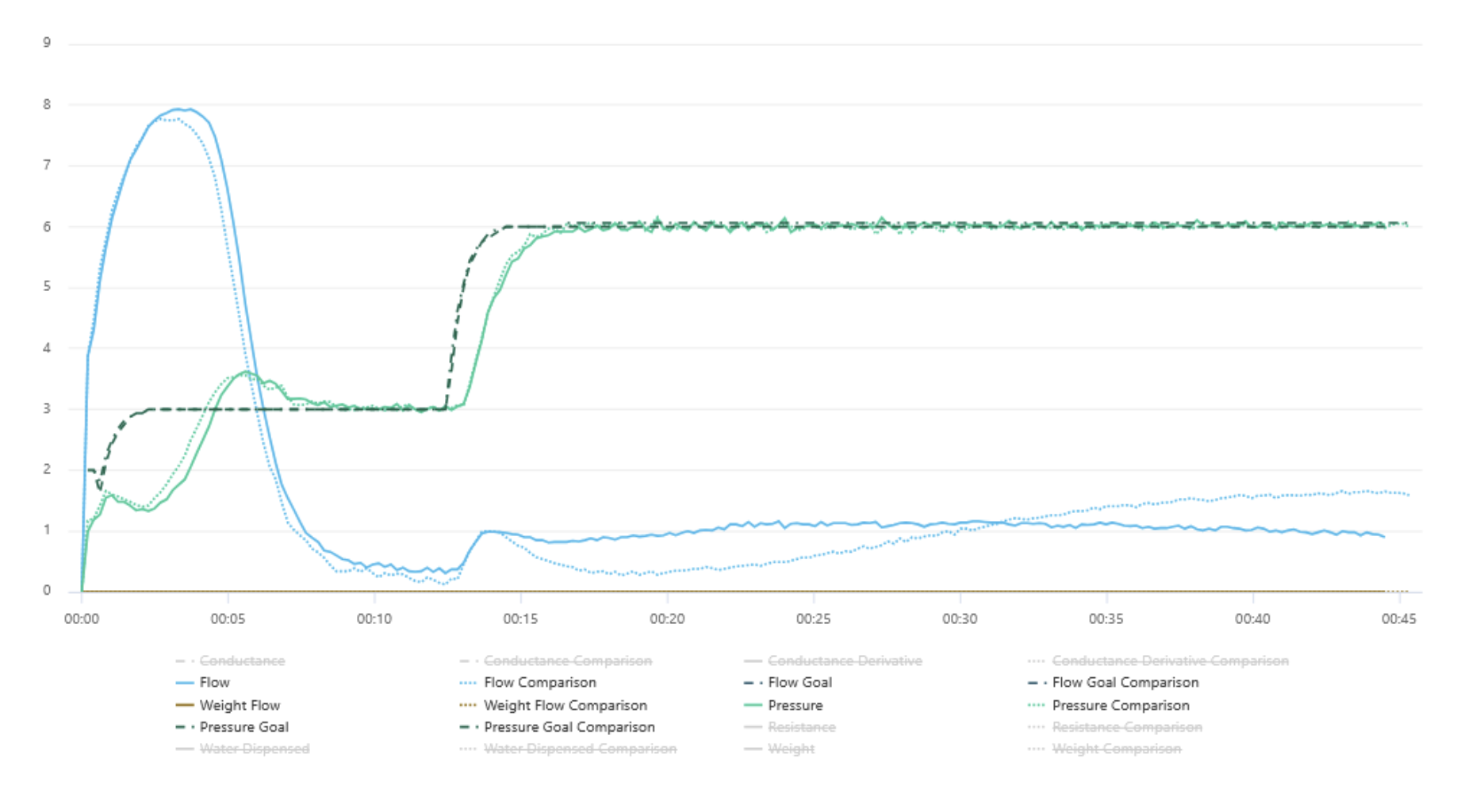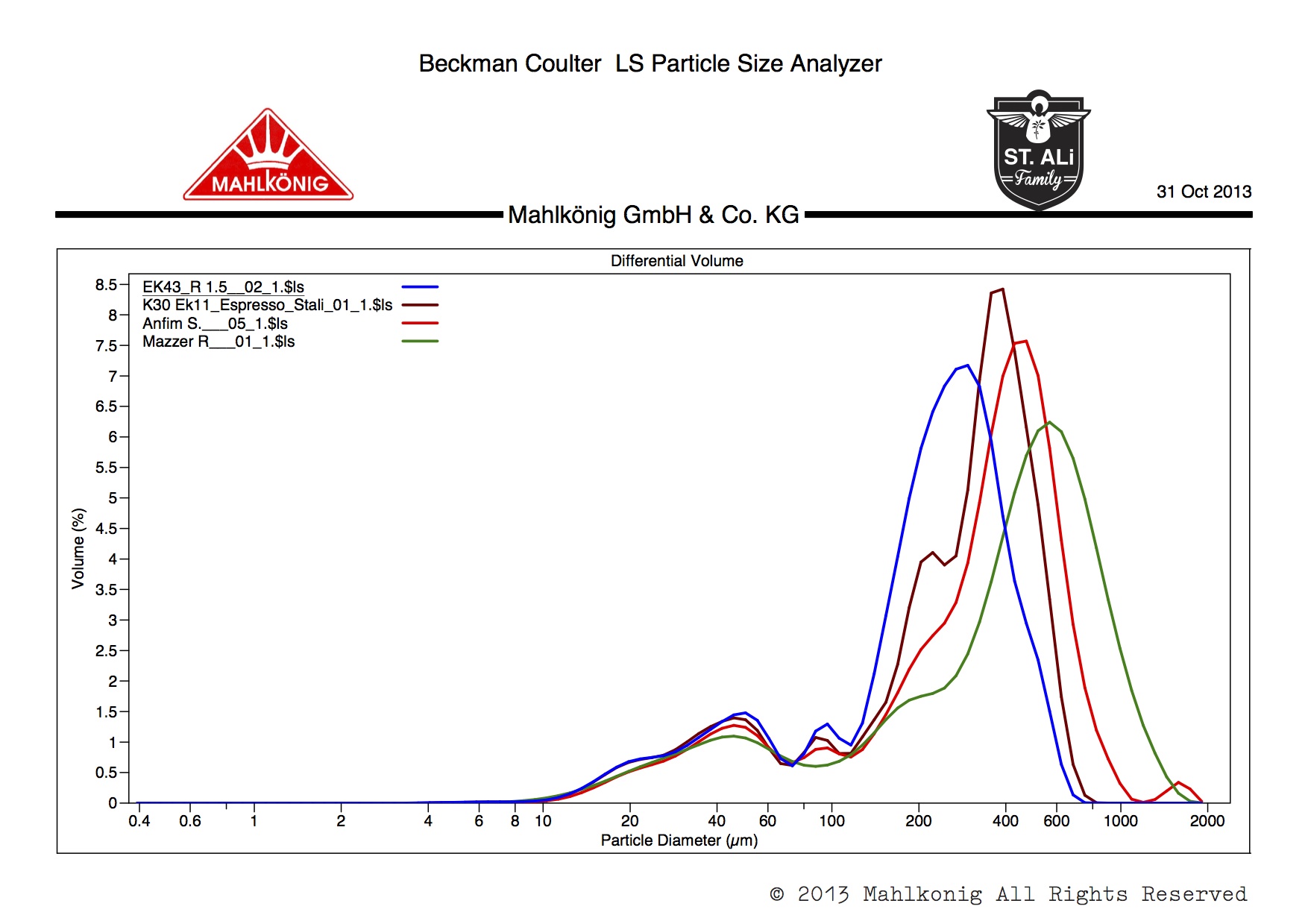Why is the flow curve shaped differently with different coffees or grinders?
If you pull two shots with different grinders, or different coffees, the shape of the flow curve (or pressure curve for flow profiles) will be different - the change in puck resistance over time will be different between the two shots. This isn't something that's visible on most espresso machines, and additionally there's sort of an implicit idea in a lot of the coffee world that the ideal is (for a constant pressure shot) for the flow rate to be moderate, and not change very much over the course of the shot.
With different coffees and different grinders, this does not always happen. Let's explore different coffees first.
Here are two shots pulled with the same grinder, with coffees from the same roaster; one is decaf (solid lines), and the other is caffeinated (fine dotted lines):

Notice that the decaf shot stayed at about the same flow rate for the entirety of the pour phase, whereas the caffeinated shot started quite slow (after the initial 1mL/s flow bump to build pressure), and rose to a higher flow rate than the decaf shot. Here, the decaf shot was actually ground slightly finer than the caffeinated shot.
So what's up with this?
Broadly speaking, flow rate during the shot is determined by three things:
- changing viscosity of the fluid inside the puck, caused by the amount of solubles in the puck changing
- viscosity is higher at the start of the shot and lower at the end, since solubles are moving from the puck to the cup
- this causes resistance to go down (flow rate goes up), all else being equal
- fines migration causing fines to dislodge from the coffee grounds and move downstream, changing the resistance the puck/filter boundary offers to incoming flow
- this causes resistance to go up, all else being equal
- the “inherent” resistance of the puck, due to the particle size distribution of the grounds - what resistance the puck would offer without the above two effects
How those first two interact is essentially what's behind the differences in how puck resistance changes between different grinders and different coffees.
With decaf, you've shifted the balance of at least the first two:
- decaf has less solubles so the resistance will change less as the solubles leave the puck
- decaf creates more fines when ground so you will see a greater effect from fines migration
- It's common to grind finer with decaf, so the inherent resistance is higher
Put these together, and we can now see why the decaf shot behaved the way it did. The decaf shot:
- dripped more during the bloom and started at a higher flow rate, despite the finer grind
- consistent with decaf having less solubles, and so offering less resistance near the start of the shot
- did not decrease appreciably in resistance, and actually increased slightly
- consistent with greater fines migration caused by the decaf processing, as well as the finer grind
If you change the grinder, you'll see largely the same type of difference, with classic, conical “espresso” grinders giving you a flow curve that will pretty much stay put through the shot, whereas modern flat burr grinders will give you a flow curve that changes more drastically, such as the caffeinated shot in the comparison above.
To explain that, let's first take a look at this particle distribution chart from the classic experiment done by Matt Perger around why shots made with the EK-43 taste and behave the way they do:  These are particle size distributions from different grinders, from “dialed in” shots of the same coffee. Note that the big flat (EK-43, blue) has a main modal peak at the smallest grind size, whereas the “classic espresso grinder,” the Mazzer Robur (green), has a main modal peak at the largest grind size.
These are particle size distributions from different grinders, from “dialed in” shots of the same coffee. Note that the big flat (EK-43, blue) has a main modal peak at the smallest grind size, whereas the “classic espresso grinder,” the Mazzer Robur (green), has a main modal peak at the largest grind size.
Now recall that first factor I listed: as the solubles exit the puck and head to your cup, the viscosity of the fluid inside the puck will decrease, causing puck resistance to decrease as well. If most of the particles are smaller, then the viscosity, and therefore resistance, will change faster.
This is why big flat grinders “extract explosively,” and why you can get away with 12 second shots with some of these grinders - the particles are so small, on average, that the coffee is highly extracted, even in shots that are that over that quickly.
In addition, despite that fact, big flat grinders tend to make pucks that have less of that “inherent resistance” that I mentioned. This is because particle distributions that are closer to “all the same size” will tend to pack less tightly than particle distributions that have a broader range of particle sizes. If you imagine sand with the particle distribution from the Robur and the EK-43, water would flow faster through the distribution matching the EK-43 for this reason.
Between these two points:
- coarser main modal peak -> resistance changes slower
- broader range of particle sizes -> tighter packing
Pucks from classic, “espresso” grinders (like the Mazzer Robur in the experiment above) will be expected to give you pucks with slowly changing, high resistance. This is exactly what leads to the moderate flow rate that doesn't change very much over the course of the shot. Shots where the puck resistance changes drastically - as you can expect it to with modern flat burr grinders - are not worse for that drastic change, rather often what that indicates is simply that extraction is happening quickly.
Updated 2025/04/22